Drive Angry/Faster/My Soul to Take/I Spit on Your Grave (2010)
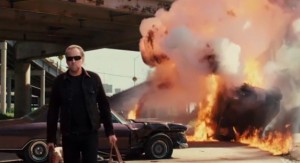 When will disreputable nihilism become boring? Hopefully never. But there comes a point where self-satisfied nastiness taken to an extreme needs a little bit of flavor to distinguish itself.
When will disreputable nihilism become boring? Hopefully never. But there comes a point where self-satisfied nastiness taken to an extreme needs a little bit of flavor to distinguish itself.
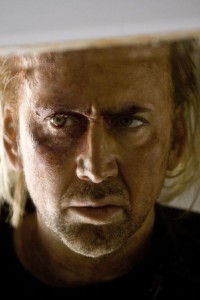 Patrick Lussier’s Drive Angry tries to spice things up with its effective use of 3D and by cobbling together as many exploitation clichés as possible: the Daisy Duke-wearing hot girl who can kick ass; the badass who grizzles, shoots and drinks; the overqualified character actor providing exposition (David Morse); and, finally, the smooth villain (Billy Burke) with better hair than the hero, if only to compensate for a lack of manhood and, as Rutger Hauer put it in Split Second, “bigger fucking guns.” The déjà vu is no doubt intentional on Lussier’s part; his 3D My Bloody Valentine remake from a few years ago brought together similar elements, but did nothing with them, other than featuring the world’s longest and most gratuitous 3D nude scene. Lussier’s fascination with inordinately lengthy nude scenes make an appearance in Drive Angry, as Amber Heard, as said ass-kicking hot girl, beats up her ex’s new beau. (A beau who happens to be standing in the middle of the street totally nude.) My Bloody Valentine had a slasher chase scene where a woman ran naked from her hotel room to a truckstop parking lot, and on and on for several minutes before her status of living was eliminated.
Patrick Lussier’s Drive Angry tries to spice things up with its effective use of 3D and by cobbling together as many exploitation clichés as possible: the Daisy Duke-wearing hot girl who can kick ass; the badass who grizzles, shoots and drinks; the overqualified character actor providing exposition (David Morse); and, finally, the smooth villain (Billy Burke) with better hair than the hero, if only to compensate for a lack of manhood and, as Rutger Hauer put it in Split Second, “bigger fucking guns.” The déjà vu is no doubt intentional on Lussier’s part; his 3D My Bloody Valentine remake from a few years ago brought together similar elements, but did nothing with them, other than featuring the world’s longest and most gratuitous 3D nude scene. Lussier’s fascination with inordinately lengthy nude scenes make an appearance in Drive Angry, as Amber Heard, as said ass-kicking hot girl, beats up her ex’s new beau. (A beau who happens to be standing in the middle of the street totally nude.) My Bloody Valentine had a slasher chase scene where a woman ran naked from her hotel room to a truckstop parking lot, and on and on for several minutes before her status of living was eliminated.
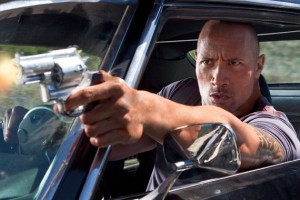 However, while you can find a thread between Lussier’s most recent films, the most unmistakable comparison to Drive Angry* seems to be last year’s vehicle for Dwayne “The Rock” Johnson, George Tillman Jr’s Faster. Both Drive Angry and Faster prefer expressing their stories in almost artlessly minimalist ways. The characters don’t even have names in Faster; they’re just known as Driver (Johnson), Cop (Billy Bob Thornton), and Killer (Oliver Jackson-Cohen). In Drive Angry, the most interesting character, immaculately dressed and amusingly deadpanned by William Fichtner, is known only as The Accountant. Sure, Nic Cage‘s character has a name, John Milton. But that sort of not-too-subtle joke was used up nearly 15 years ago in the similarly devil-themed The Devil’s Advocate. [Drive Angry unfortunately features not one reference to Paradise Lost.]
However, while you can find a thread between Lussier’s most recent films, the most unmistakable comparison to Drive Angry* seems to be last year’s vehicle for Dwayne “The Rock” Johnson, George Tillman Jr’s Faster. Both Drive Angry and Faster prefer expressing their stories in almost artlessly minimalist ways. The characters don’t even have names in Faster; they’re just known as Driver (Johnson), Cop (Billy Bob Thornton), and Killer (Oliver Jackson-Cohen). In Drive Angry, the most interesting character, immaculately dressed and amusingly deadpanned by William Fichtner, is known only as The Accountant. Sure, Nic Cage‘s character has a name, John Milton. But that sort of not-too-subtle joke was used up nearly 15 years ago in the similarly devil-themed The Devil’s Advocate. [Drive Angry unfortunately features not one reference to Paradise Lost.]
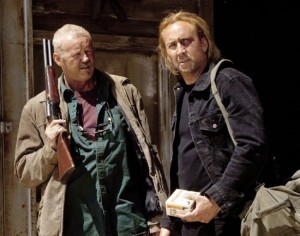 Did you not know that Drive Angry had a supernatural theme? Certainly the advertising is trying to hide that fact, which is a shame because the fact that Cage’s character** has escaped from hell to try to rescue his granddaughter from being sacrificed by a devil-worshipping cult leader should have been laid out in the first five minutes. Hiding this backstory is a mistake. It’s obvious to us for the first hour, and we’re just impatient while the movie pretends it’s just about Milton being a seemingly indestructible loner with lightning quick reflexes and a wide array of unique weaponry. The carnage piles up long before we learn most of it was meaningless. And while it’s all over the top and well-executed, it appears they should have just started the movie at the first reveal and continued developing from there.
Did you not know that Drive Angry had a supernatural theme? Certainly the advertising is trying to hide that fact, which is a shame because the fact that Cage’s character** has escaped from hell to try to rescue his granddaughter from being sacrificed by a devil-worshipping cult leader should have been laid out in the first five minutes. Hiding this backstory is a mistake. It’s obvious to us for the first hour, and we’re just impatient while the movie pretends it’s just about Milton being a seemingly indestructible loner with lightning quick reflexes and a wide array of unique weaponry. The carnage piles up long before we learn most of it was meaningless. And while it’s all over the top and well-executed, it appears they should have just started the movie at the first reveal and continued developing from there.
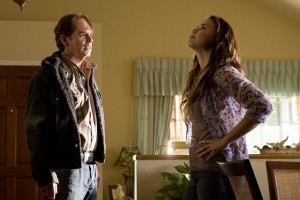 Faster throws away any nonsense about convincing backstory by having The Driver get out of prison. (Milton claims that he escaped “prison” until the plot reveal.) He finds out where his targets are, walks up to them and shoots them in the head. No aftermath. He just leaves and moves on to the next guy who he holds responsible for his incarceration and his brother’s death. As with Drive Angry, a name actor shows up to solely provide exposition (Carla Gugino in Faster) and then hang back from the action until it’s over and the name actor can take over for the “hero.” Faster also has the same bleached, sun-drenched photography as Drive Angry, with a large number of scenes involving The Driver/John Milton squinting through the afternoon sun behind the wheel of their 1970s muscle cars.
Faster throws away any nonsense about convincing backstory by having The Driver get out of prison. (Milton claims that he escaped “prison” until the plot reveal.) He finds out where his targets are, walks up to them and shoots them in the head. No aftermath. He just leaves and moves on to the next guy who he holds responsible for his incarceration and his brother’s death. As with Drive Angry, a name actor shows up to solely provide exposition (Carla Gugino in Faster) and then hang back from the action until it’s over and the name actor can take over for the “hero.” Faster also has the same bleached, sun-drenched photography as Drive Angry, with a large number of scenes involving The Driver/John Milton squinting through the afternoon sun behind the wheel of their 1970s muscle cars.
 And the casting choices cannot be a coincidence; as if Billy Bob Thornton was supposed to play the villain in Drive Angry, but backed out to do Faster, so Lussier dressed the replacement in one of Billy Bob’s wigs, clothes, and accent, and made sure one of his minions was a dead ringer for Thornton’s ex-wife Angelina Jolie. Was Lussier the one who was really angry, and that’s why the Billy Bob part is turned into a eunuch?
And the casting choices cannot be a coincidence; as if Billy Bob Thornton was supposed to play the villain in Drive Angry, but backed out to do Faster, so Lussier dressed the replacement in one of Billy Bob’s wigs, clothes, and accent, and made sure one of his minions was a dead ringer for Thornton’s ex-wife Angelina Jolie. Was Lussier the one who was really angry, and that’s why the Billy Bob part is turned into a eunuch?
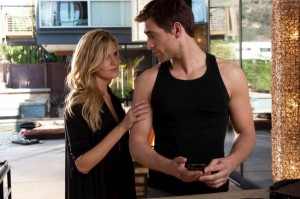 If there’s a difference between the films it’s that, before its ill-conceived biblically themed finale, Faster is thoroughly simplistic. Only the addition of a prosperous and bored contract killer (Jackson-Cohen) worrying about whether or not he can bring a woman into his life is extraneous. In between killings, The Driver stops to talk to someone who can fill in the backstory for the rest of us, whether it’s Mike Epps as a bail bondsman, Jennifer Carpenter as an ex***, and on and on. The rhythm is so predictable it almost mimics the way the races and the sex scenes were divided in Death Race 2000. [Pit stop. Time for sex.] The monotony helps Faster in the same way it hurts Drive Angry, especially considering Cage’s absolutely flat, monotone performance.
If there’s a difference between the films it’s that, before its ill-conceived biblically themed finale, Faster is thoroughly simplistic. Only the addition of a prosperous and bored contract killer (Jackson-Cohen) worrying about whether or not he can bring a woman into his life is extraneous. In between killings, The Driver stops to talk to someone who can fill in the backstory for the rest of us, whether it’s Mike Epps as a bail bondsman, Jennifer Carpenter as an ex***, and on and on. The rhythm is so predictable it almost mimics the way the races and the sex scenes were divided in Death Race 2000. [Pit stop. Time for sex.] The monotony helps Faster in the same way it hurts Drive Angry, especially considering Cage’s absolutely flat, monotone performance.
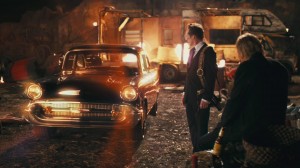 At least Drive Angry can cut away to Fichtner, who practically functions as Satan’s PR man. Lussier handles some of the film with some wit (“does that fire make you homesick?”) especially in the truly creative manipulation of 3D. There’s one shot that seems to be a double exposure, a deep focus, and mid-dissolve shot that actually achieves the surreal otherworldly effect that 3D optimally would all the time, if it weren’t so reliant on being gimmicky.
At least Drive Angry can cut away to Fichtner, who practically functions as Satan’s PR man. Lussier handles some of the film with some wit (“does that fire make you homesick?”) especially in the truly creative manipulation of 3D. There’s one shot that seems to be a double exposure, a deep focus, and mid-dissolve shot that actually achieves the surreal otherworldly effect that 3D optimally would all the time, if it weren’t so reliant on being gimmicky.
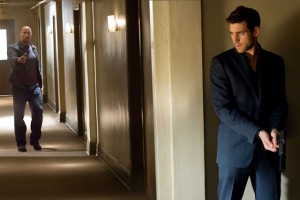 Faster’s gimmick is that it’s so serious about its nonsense. How do we know that The Driver is a bad motherfucker? Why, when he is given a speech by the prison warden (played by Tom Berenger, whose meaningless part, like with Cillian Murphy in Tron: Legacy, suggests that elaboration was coming in a now never-to-be-made sequel) and Berenger hands him his business card in case he needs someone to talk to, the first thing The Driver does once he’s beyond the prison doors is to dramatically throw the card away. What is the essence of a man… who can throw away up cardboard with such vigor?
Faster’s gimmick is that it’s so serious about its nonsense. How do we know that The Driver is a bad motherfucker? Why, when he is given a speech by the prison warden (played by Tom Berenger, whose meaningless part, like with Cillian Murphy in Tron: Legacy, suggests that elaboration was coming in a now never-to-be-made sequel) and Berenger hands him his business card in case he needs someone to talk to, the first thing The Driver does once he’s beyond the prison doors is to dramatically throw the card away. What is the essence of a man… who can throw away up cardboard with such vigor?
Such a lack of irony can be an advantage. That’s because then self-awareness can’t take over — like it did for Patrick Lussier’s longtime editing and producing partner Wes Craven and his just released to DVD My Soul to Take (post-converted 3D in the theater, 2D at home) and Steven R. Monroe’s remake of I Spit on Your Grave that, after a protracted theatrical run, was released on the same day as My Soul to Take.
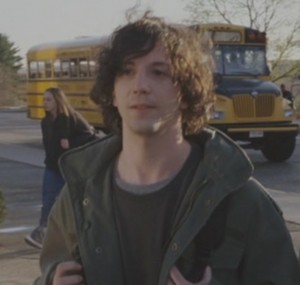 Perhaps too conscious of the Scream association, Craven worries so much about artifice throughout My Soul to Take that there ends up being nothing else to grab onto. Shot in a woozy, overlit dream-sequence texture and stuffed with at least 10 too many characters, My Soul to Take is a high school drama that occasionally has a cameo by a slasher movie trying to rudely intrude upon the proceedings. Clunky bird metaphors, blind kids grabbing for dangling ropes, a Horshack-ian best friend with an abusive stepfather, and a story that would be eliminated had any of these high school kids actually driven cars (they live in the middle of nowhere, Wes, why are they walking everywhere?), sum up most of the more obvious problems with the film.
Perhaps too conscious of the Scream association, Craven worries so much about artifice throughout My Soul to Take that there ends up being nothing else to grab onto. Shot in a woozy, overlit dream-sequence texture and stuffed with at least 10 too many characters, My Soul to Take is a high school drama that occasionally has a cameo by a slasher movie trying to rudely intrude upon the proceedings. Clunky bird metaphors, blind kids grabbing for dangling ropes, a Horshack-ian best friend with an abusive stepfather, and a story that would be eliminated had any of these high school kids actually driven cars (they live in the middle of nowhere, Wes, why are they walking everywhere?), sum up most of the more obvious problems with the film.
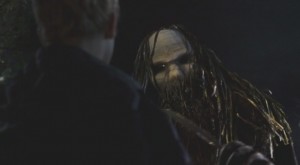 But really, the issue is more organizational, as Craven pulls a Brian De Palma by putting all his energy into the illogical but generally thrilling opening, and then taking a lengthy nap during the remainder of the production (Femme Fatale being the best example). Craven did something similar with Scream, the first sequence with Drew Barrymore is far better than anything else in the film, but the rest of the movie is still competent and funny, not the lazy mess that My Soul to Take turns into once it moves on from the intro-murders and ambulance crashes. It’s not that Craven had to lay out the pieces carefully in order to satisfy the audience, but he doesn’t even make it past the first minute of teenage hijinks before the incompetence plants its flag.
But really, the issue is more organizational, as Craven pulls a Brian De Palma by putting all his energy into the illogical but generally thrilling opening, and then taking a lengthy nap during the remainder of the production (Femme Fatale being the best example). Craven did something similar with Scream, the first sequence with Drew Barrymore is far better than anything else in the film, but the rest of the movie is still competent and funny, not the lazy mess that My Soul to Take turns into once it moves on from the intro-murders and ambulance crashes. It’s not that Craven had to lay out the pieces carefully in order to satisfy the audience, but he doesn’t even make it past the first minute of teenage hijinks before the incompetence plants its flag.
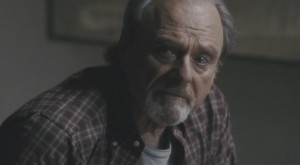 Yes, you do have to introduce the effect a deranged serial killer has had on a small suburban town. But you ought to try to have the costume that the kids have come up with to indulge the legend not look exactly like the Predator. Yes, there are teenagers who are into gory movies, even some of yours, but pretending that a teenager in this century who would watch Alfred Hitchock‘s The Birds for gory pleasure is ridiculous. The artificiality of The Birds is very much part of the design, but it’s not going to scare or satisfy any gorehounds. Yes, suburban houses can look all the same, but that’s no excuse for your interior sets to be so distractingly phony-looking and cheap. Yes, it’s good to keep things mysterious for later surprises. But it’s of no use to hide the fact — for an hour — that two of the characters are brother and sister when hiding that fact has no effect on the story one way or the other and it just ends up being confusing. Yes, mothers sometimes have nicknames for their children, often derivations of their original name as a term of affection. Bug is not a term of affection. Yes, red herrings and talking killers (in this case, the talking killer runs away after explaining everything) are the norm for the slasher horror genre, and the identity of the villain should remain mysterious for as long as possible. But that doesn’t mean that the eventual reveal is impossible, as there’s no way this particular person could have even been at half the places he supposedly was. Yes, we get that filmmakers often have characters stand in as their surrogates. And, in this case, Harris Yulin dresses up as almost a mirror image of Craven. But in his scenes, Yulin looks like he’d rather be doing anything else, perhaps polishing his shoes, or maybe canvassing the neighborhood for discarded furniture to ensure bed bugs. But certainly not to be in My Soul to Take. And maybe that’s the message that Craven wanted to send to us.
Yes, you do have to introduce the effect a deranged serial killer has had on a small suburban town. But you ought to try to have the costume that the kids have come up with to indulge the legend not look exactly like the Predator. Yes, there are teenagers who are into gory movies, even some of yours, but pretending that a teenager in this century who would watch Alfred Hitchock‘s The Birds for gory pleasure is ridiculous. The artificiality of The Birds is very much part of the design, but it’s not going to scare or satisfy any gorehounds. Yes, suburban houses can look all the same, but that’s no excuse for your interior sets to be so distractingly phony-looking and cheap. Yes, it’s good to keep things mysterious for later surprises. But it’s of no use to hide the fact — for an hour — that two of the characters are brother and sister when hiding that fact has no effect on the story one way or the other and it just ends up being confusing. Yes, mothers sometimes have nicknames for their children, often derivations of their original name as a term of affection. Bug is not a term of affection. Yes, red herrings and talking killers (in this case, the talking killer runs away after explaining everything) are the norm for the slasher horror genre, and the identity of the villain should remain mysterious for as long as possible. But that doesn’t mean that the eventual reveal is impossible, as there’s no way this particular person could have even been at half the places he supposedly was. Yes, we get that filmmakers often have characters stand in as their surrogates. And, in this case, Harris Yulin dresses up as almost a mirror image of Craven. But in his scenes, Yulin looks like he’d rather be doing anything else, perhaps polishing his shoes, or maybe canvassing the neighborhood for discarded furniture to ensure bed bugs. But certainly not to be in My Soul to Take. And maybe that’s the message that Craven wanted to send to us.
![twiz-spitonyourgrave-unrtd-cd1[(057953)23-03-50]](http://www.regrettablesincerity.com/wp-content/uploads/2011/02/twiz-spitonyourgrave-unrtd-cd105795323-03-50-300x127.jpg) I’m pretty sure that Steven Monroe wanted to be on set to remake Meir Zarchi’s accidentally impactful rape-revenge “classic” I Spit on Your Grave. I’m pretty sure the 2010 version is exactly the movie Monroe wanted to make. When I interviewed Daniel Franzese while he was on the set making the film (Franzese plays one of the four rapists), considering the overt ineptitude of the original, I asked him what exactly a “good” version of this movie would look like. It’s hard to think of a rape/revenge movie that doesn’t wallow in unpleasant exploitation and misogyny, but Daniel tried his best to sell me on it, stating that the movie was tasteful, but explicit.
I’m pretty sure that Steven Monroe wanted to be on set to remake Meir Zarchi’s accidentally impactful rape-revenge “classic” I Spit on Your Grave. I’m pretty sure the 2010 version is exactly the movie Monroe wanted to make. When I interviewed Daniel Franzese while he was on the set making the film (Franzese plays one of the four rapists), considering the overt ineptitude of the original, I asked him what exactly a “good” version of this movie would look like. It’s hard to think of a rape/revenge movie that doesn’t wallow in unpleasant exploitation and misogyny, but Daniel tried his best to sell me on it, stating that the movie was tasteful, but explicit.
![twiz-spitonyourgrave-unrtd-cd1[(031853)23-02-44]](http://www.regrettablesincerity.com/wp-content/uploads/2011/02/twiz-spitonyourgrave-unrtd-cd103185323-02-44-300x127.jpg) Funny that my reaction after seeing it was that it was neither tasteful nor explicit. Retaining the basic elements of the original, Monroe gives us the pretty waifish writer up in the hills for some privacy (hasn’t she heard of a writer’s colony?) who runs into some horny, pasty rednecks in search of some rapin’. When the inevitable happens, including the forced inclusion of a mentally challenged fellow, they leave her for dead and she plans her elaborate revenge. There’s nothing else to the movie, either in the original or remake, which, for something so slight, is awfully long for a film. (The remake is 107 minutes long.) It’s long for a film that has no character development, dialogue and mostly consists of the male leads waiting around to be killed.
Funny that my reaction after seeing it was that it was neither tasteful nor explicit. Retaining the basic elements of the original, Monroe gives us the pretty waifish writer up in the hills for some privacy (hasn’t she heard of a writer’s colony?) who runs into some horny, pasty rednecks in search of some rapin’. When the inevitable happens, including the forced inclusion of a mentally challenged fellow, they leave her for dead and she plans her elaborate revenge. There’s nothing else to the movie, either in the original or remake, which, for something so slight, is awfully long for a film. (The remake is 107 minutes long.) It’s long for a film that has no character development, dialogue and mostly consists of the male leads waiting around to be killed.
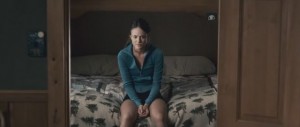 What does Monroe fill the time with then? Glibness, mostly. This supposedly successful writer can do no better than spit back “clever” versions of her attackers own invective. “Is that any way to talk to a lady?” It’s a shame because there was an opportunity to explore certain underlying issues in rapists. In this case, the girl played by Sarah Butler, who looks an awful lot like Kristen Stewart, is a woman with a little girl’s body, skinny, almost nothing in the way of breasts. Why not look at the seemingly sourceless anger that the male offenders are filled with, and how they take it out on someone who is physically so much like a young boy? When the lead rapist**** (a low-rent version of Michael Shannon played by Jeff Branson) blurts out, “I want to see your titties,” my first thought was, “but she doesn’t have any.”
What does Monroe fill the time with then? Glibness, mostly. This supposedly successful writer can do no better than spit back “clever” versions of her attackers own invective. “Is that any way to talk to a lady?” It’s a shame because there was an opportunity to explore certain underlying issues in rapists. In this case, the girl played by Sarah Butler, who looks an awful lot like Kristen Stewart, is a woman with a little girl’s body, skinny, almost nothing in the way of breasts. Why not look at the seemingly sourceless anger that the male offenders are filled with, and how they take it out on someone who is physically so much like a young boy? When the lead rapist**** (a low-rent version of Michael Shannon played by Jeff Branson) blurts out, “I want to see your titties,” my first thought was, “but she doesn’t have any.”
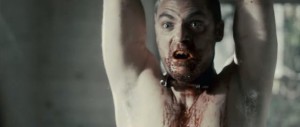 The rapes themselves are relatively chaste and Monroe’s comes up with one striking image that probably went through some digital manipulation. Naked, moving slowly, covered in dirt and leaves, Butler sways from side to side like her limbs have all been broken, rubbery and otherworldly, as the rapists come back for more. The interest level wanes right after that, and Monroe’s mistake in not detailing the rape (so it has a real impact on the audience) is exacerbated by how ridiculous and elaborate the revenge is. It’s not that they don’t deserve punishment. But the scale here is so out-of-whack with what we’re shown, with one battered, tiny girl devising and executing tortures that would have required several construction crews and a team of black ops agents. All that we’ve seen of her options were that of a tool-shed (ham-fistedly foreshadowed) on her rental property’s premises and some rusty tools held within.
The rapes themselves are relatively chaste and Monroe’s comes up with one striking image that probably went through some digital manipulation. Naked, moving slowly, covered in dirt and leaves, Butler sways from side to side like her limbs have all been broken, rubbery and otherworldly, as the rapists come back for more. The interest level wanes right after that, and Monroe’s mistake in not detailing the rape (so it has a real impact on the audience) is exacerbated by how ridiculous and elaborate the revenge is. It’s not that they don’t deserve punishment. But the scale here is so out-of-whack with what we’re shown, with one battered, tiny girl devising and executing tortures that would have required several construction crews and a team of black ops agents. All that we’ve seen of her options were that of a tool-shed (ham-fistedly foreshadowed) on her rental property’s premises and some rusty tools held within.
![twiz-spitonyourgrave-unrtd-cd2[(002684)23-07-15]](http://www.regrettablesincerity.com/wp-content/uploads/2011/02/twiz-spitonyourgrave-unrtd-cd200268423-07-15-300x127.jpg) The slapped together feel of the film is hammered home by the inclusion of a sheriff who takes part in the abuse. Why he does is unclear, other than that when Butler finds him in the woods and tries to tell him what happened, the movie would have been over. The sheriff (think Elias Koteas) has a wife who is physically out of his league and several kids (who are of course used against him). He’s not a bored 20-something alcoholic living with his parents, unlikely to have a way to properly express his misogyny. Clearly his wife is attractive and isn’t leaving him hard up considering she’s pregnant at the time. Which of course means her breasts have gotten bigger. Wait a minute. Now I get it.
The slapped together feel of the film is hammered home by the inclusion of a sheriff who takes part in the abuse. Why he does is unclear, other than that when Butler finds him in the woods and tries to tell him what happened, the movie would have been over. The sheriff (think Elias Koteas) has a wife who is physically out of his league and several kids (who are of course used against him). He’s not a bored 20-something alcoholic living with his parents, unlikely to have a way to properly express his misogyny. Clearly his wife is attractive and isn’t leaving him hard up considering she’s pregnant at the time. Which of course means her breasts have gotten bigger. Wait a minute. Now I get it.
 * Another Avi Lerner/Millenium Films movie that takes place in and takes advantage of Louisiana tax breaks.
* Another Avi Lerner/Millenium Films movie that takes place in and takes advantage of Louisiana tax breaks.
** As usual, Cage’s hair is fantastically ridiculous looking. Since the title Drive Angry obviously sounded cooler than it was actually relevant to the film at hand, they might have thought about changing it to: Frightwigs and Fairytales.
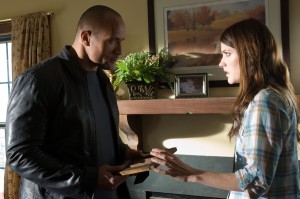 *** The movie, considering its purely visceral barrage of graphic violence, makes a misstep in Carpenter’s scene, as it makes a moral judgment about her having had an abortion. There is also an unwillingness to present anything as shades of grey, as one of Johnson’s victims is an elderly man, who conveniently happens to also like to rape young girls. He can’t just be a guy who happens to have wronged Johnson, they have to pile on so there’s no question that the right guy is being punished.
*** The movie, considering its purely visceral barrage of graphic violence, makes a misstep in Carpenter’s scene, as it makes a moral judgment about her having had an abortion. There is also an unwillingness to present anything as shades of grey, as one of Johnson’s victims is an elderly man, who conveniently happens to also like to rape young girls. He can’t just be a guy who happens to have wronged Johnson, they have to pile on so there’s no question that the right guy is being punished.
**** One of the rapists has a moment worthy of David Caruso’s campy hall of fame line delivery in Session 9. In that case the camera swung towards Caruso and he screamed out, in his unique intensity, “Fuck You!” You can find the clip on Youtube. In I Spit on Your Grave has a similar scene where he offers, “I shit you not!”



